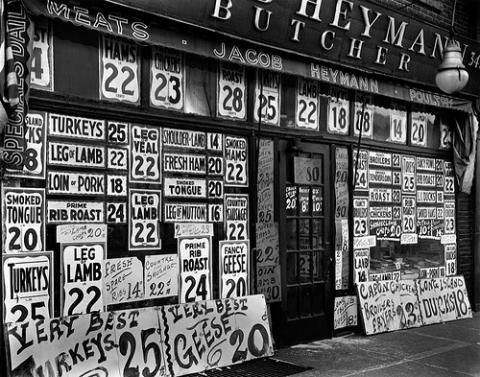
Photo: Jacob Heymann Butcher Shop, 345 Sixth Avenue, New York City. Taken in 1938 by WPA photographer Berenice Abbott. Source: Flickr.
Local farmer Shannon Hayes, who raises grass-fed pigs, cows, sheep and chickens at Sap Bush Hollow Farm in West Fulton, has an essay in Yes Magazine this week about why she charges $7.50 a pound for ground beef -- and why that's just fine.
Every week, we meet someone who tells us the prices are too high.
In fact, at those prices, the average net income for our family members has maxed out at $10 per hour. But part of our job is to hold our chins up and accept weekly admonishment for our inability to produce food as cheaply as it can be found in the grocery store.
Hayes, author of Radical Homemakers and a regular contributor to Yes Magazine, argues that the true costs of large-scale agriculture -- invisible subsidies, environmental degradation, food-related illness -- are not reflected in the price of a factory-farmed cut at the grocery store.
The "true cost" of industrially raised food, especially meat and animal products, has become something of a mantra in the food world. But not all small farmers believe that local-food prices should be so high.
Here's a contrarian view on the subject from another Schoharie County farmer: Bob Comis, who raises pigs and sheep at Stony Brook Farm in Schoharie. In 2009, Comis wrote an essay for the Ethicurean called "Unfair fare: Why prices for meat from small local farms are too high."
Comis argues that while local meat cannot and should not compete with industrial producers on price, prices would come down if small-scale farmers would commit to raising more animals. An excerpt:
The next time you talk to your livestock farmer, ask him or her what their production volume is. You might be surprised to find out just how many local farmers are finishing just a dozen pigs (or even a few dozen), a few hundred chickens (or even a thousand), and/or just a handful of cows per year. Based on reasonable prices, cash flow on that volume is extremely low, and the cash flow requirements of fixed costs such as land, buildings, and equipment is very high, so those low-volume local farmers have to charge outrageous prices to bump up their cash flow.
Comis farms full-time, and blogs about it at stonybrookfarm.wordpress.com.











